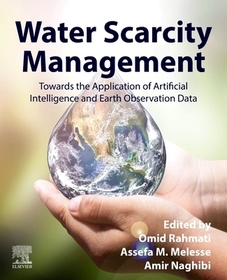
Water Scarcity Management
Toward the Application of Artificial Intelligence and Earth Observation Data
-
10% KEDVEZMÉNY?
- A kedvezmény csak az 'Értesítés a kedvenc témákról' hírlevelünk címzettjeinek rendeléseire érvényes.
- Kiadói listaár EUR 172.99
-
71 747 Ft (68 331 Ft + 5% áfa)
Az ár azért becsült, mert a rendelés pillanatában nem lehet pontosan tudni, hogy a beérkezéskor milyen lesz a forint árfolyama az adott termék eredeti devizájához képest. Ha a forint romlana, kissé többet, ha javulna, kissé kevesebbet kell majd fizetnie.
- Kedvezmény(ek) 10% (cc. 7 175 Ft off)
- Kedvezményes ár 64 573 Ft (61 498 Ft + 5% áfa)
Iratkozzon fel most és részesüljön kedvezőbb árainkból!
Feliratkozom
71 747 Ft

Beszerezhetőség
Még nem jelent meg, de rendelhető. A megjelenéstől számított néhány héten belül megérkezik.
Why don't you give exact delivery time?
A beszerzés időigényét az eddigi tapasztalatokra alapozva adjuk meg. Azért becsült, mert a terméket külföldről hozzuk be, így a kiadó kiszolgálásának pillanatnyi gyorsaságától is függ. A megadottnál gyorsabb és lassabb szállítás is elképzelhető, de mindent megteszünk, hogy Ön a lehető leghamarabb jusson hozzá a termékhez.
A termék adatai:
- Kiadó Elsevier Science
- Megjelenés dátuma 2025. november 1.
- ISBN 9780443267222
- Kötéstípus Puhakötés
- Terjedelem404 oldal
- Méret 276x216 mm
- Nyelv angol 700
Kategóriák
Hosszú leírás:
Drought and the condition of water scarcity lead to several socio-economic, social and environmental impacts. Whatever the approaches of drought management, policymakers and planners require novel methods to analyze data and model drought processes and its connection with water scarcity. In recent years, artificial intelligence-based and earth observation approaches have been progressively developed and applied in domain of water-related disasters. The target of this book is to present new advances and achievements in the fields of drought monitoring, analyzing, and modeling using artificial intelligence algorithms (e.g., machine learning, deep learning, etc.), statistical indices, and a diverse range of satellite remote sensing and geo-spatial data sets. Water Scarcity Management: Towards the Application of Artificial Intelligence and Earth Observation Data will help students gain knowledge on drought prediction using new free-access earth observation data and machine learning models. It will also guide scientists, researchers, and urban planners with the monitoring of water resources and key elements of hydrological cycle.
TöbbTartalomjegyzék:
1. Water scarcity crisis: overview of challenges and solutions
2. Assessing Dust Storm Risks in Water-Scarce Regions: A Machine Learning Approach
3. An Integrated Machine Learning Framework for Flood Susceptibility Assessment
4. Application of GRACE satellite data to monitor groundwater storage and scarcity
5. Discover the world of drought and water scarcity indices: insights for a sustainable future
6. Exploring the Interplay of Water Scarcity and Dust Emissions
7. Groundwater potential mapping: a way for mitigating water scarcity
8. The role of climatic and anthropogenic factors in drying up of lakes
9. Integrated assessment of the vulnerability of socio-ecological coupled systems of coastal areas to drought
10. The effect of climatic and human factors on hydrological drought
11. Machine Learning-Driven Land Subsidence Prediction Using Radar Imagery
12. Remote Sensing for Assessing Ecosystem Drought Impact
13. Ground Subsidence and Groundwater Dynamics: the Role of InSAR Analysis in Confined Aquifer Systems
14. Drought mitigation and management measures
15. Technological Innovations in Water Conservation: Navigating Drought and Water Scarcity
16. Vegetation dynamics as a response to meteorological drought
17. Machine Learning in Groundwater Drought Forecasting: A Bibliometric Perspective
18. Decoding the Water Crisis in Iran: Policy Challenges and Resource Constraints
19. Human effects of dam construction on the downstream ecosystem
20. Climatic influences on vegetation degradation and soil moisture
21. Holistic Water Resource Management in Scarcity: Policy Frameworks and Practical Solutions




